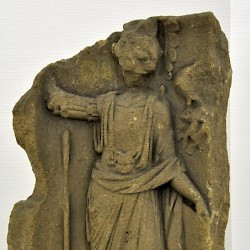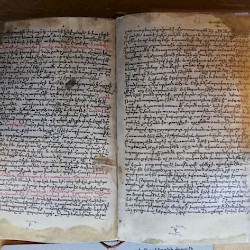Jona Lendering
Jona Lendering read history at Leiden University (MA 1993), specialized in Mediterranean culture at the Amsterdam Free University (MA 1996), and worked at excavations in Holland (Riethoven) and Greece (Halos). After teaching historical theory and ancient history at the Free University for several years, he was one of the founders of a school for history teaching, Livius Onderwijs. Born in Amsterdam, it has now spread to auxiliary locations in Bussum, Dronten, Gouda, Haarlem, Hoorn, Schagen, Zaanstad, and Zoetermeer. As of 2013, Livius Onderwijs has eight teachers, about 500-600 students a year, and offers tours to countries like Italy, Turkey, Iran, and Lebanon. The field trips help to etch into the students' minds some of what they've learned at the school.
Because history is for a large part telling a story, something you do best in your own language, Lendering prefers to publish in Dutch journals. However, he has contributed to the Bryn Mawr Classical Review and Ancient Warfare, while he is the founder of Ancient History Magazine. He is also the publisher and editor of the on-line publication of the Babylonian Chronicles of the Hellenistic Period, a set of important cuneiform sources for the history of the Seleucid and Parthian Near East, transcribed, translated and commented on by Bert van der Spek of the Free University Amsterdam and Irving Finkel of the British Museum. A publication as book is in preparation.
Lendering has written several books and maintains a blog in Dutch. He is the author of several books, including Edge of Empire and Consensus and Crises. For the Livius website, which has received several awards, he collaborates closely with Bill Thayer of LacusCurtius. Lendering is also the webmaster of two daily blogs, the MainzerBeobachter.com and Grondslagen.net.
There are 9380 items in Jona Lendering:
Arlon, Institut Archéologique du Luxembourg
It is a bit confusing that the Institut Archéologique du Luxembourg is apparently not in Luxembourg. In the nineteenth century, the old archduchy was divided into two halves; the western part became part of Belgium, the eastern part became an…

Arlon, Relief of Minerva |
Armenia
Armenia (Akkadian Uraštu; Old Persian Armina): ancient kingdom, situated along the river Araxes (modern Aras), the Upper Tigris and the Upper Euphrates. For the early history of Armenia, see Urartu.Achaemenid Armenia …Armenia (2)
Armenia: ancient kingdom, situated along the river Araxes (modern Aras), the Upper Tigris and the Upper Euphrates. For the early history of Armenia, see Urartu.Armenia between Rome and Parthia From now on, Armenia was one of the battlegrounds between the Romans and…

Armenian manuscript with Coptic Refutations of the Decisions of the Council of Chalcedon |
Arminius
Arosis? (Marun)
Marun: river in Iran, border between Elam and Persis. The river Marun At the time of its flood, i.e., during the late…Arrian
Arrian of Nicomedia (c.87 - after 145): Greek historian and senator of the Roman empire, author of several historical studies. His best-known work is the Anabasis, which deals with Alexander the Great.Life …Arsaces I
Arsaces I: Parnian king (r.247-211), founder of the Arsacid Dynasty and the Parthian Empire. Arsaces I After the fall of the Achaemenid Empire,…Arsaces II
Arsaces II: Arsacid king of the Parni in Parthia (r.211-185), second king of the Parthian Empire. Portrait of a Parthian After Arsaces and his brother…Arsaces III Phriapatius
Arsaces III Phriapatius: Arsacid king of the Parni in Parthia (r.185-170), third king of the Parthian Empire. Portrait of a Parthian In the third quarter…Arsaces IV
Arsaces IV: Arsacid king of the Parni in Parthia (r.170-168), fourth king of the Parthian Empire.Arsaces IV appears to have been the son of Arsaces II, who became king of the Parni in Parthia after Arsaces III Phriapatius: In these years, the…